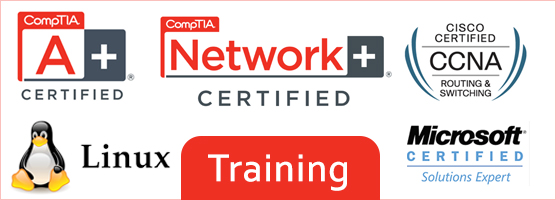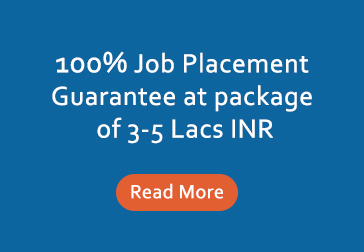POPULAR JOB GUARANTEE COURSES
ICP Training (100% Job Placement Guarantee Program)
A+, N+, MCSE, CCNA, Linux
Course Details
Minimum Qualification of candidates 12th / B.A. / B.Sc / B.C.A.
Time Duration: - 12 Month (6 month Academic + 6 month industrial training)
Salary Package: - 10,000/- to 15000/- per month.
Training Fees: - 65,500/- (candidate can pay in three installments)

A+
Operating System Technologies:
-
Introduction to Computers
Types of Software & languages
Introduction to Operating System (DOS):
Introduction to OS Booting sequence in DOS
Internal & external commands.
Working with Windows 98 :
Hardware profiles
System and memory Resource management
Boot sequence
System management and maintenance tools
Registry monitoring tools and troubleshooting resources.
Working with Windows 2000:
Installing Windows 2000 Professional and Server
Administration tools
Microsoft Management Consoles
Basic disk management
The boot process
System recovery using safe mode
Using Device manager.
Networking with Windows 98 and 2000:
Discussion on TCP/IP.
Installing Network adapters, protocols and services
Discussion of Workgroup or Domain models
Mapping network and printer connections.
PC Support (Core Hardware):
Assembling & Installation:
Add on card identification
Assembling a computer
Installation of DOS, 95,98,ME, MS-Office etc.,
Configuration of display, sound card.
Basic Electronics:
Resistors, capacitors and Inductors
Conductors, Insulators and semiconductors
Comparison between AC and DC Current
Diodes and transistors
Rectifiers and voltage Regulators.
Digital Electronics:
Number System and conversion
Basic logic gates (NOT, AND, OR)
Universal gates (NAND, NOR)
Flip flops (RS, D and JK)
Counters, Shift registers
Multiplexer and De-multiplexer
Introduction to Integrated Circuits.
Microprocessor and Support chips:
Difference between 8085,8086 and 8088
Data, Address and control bus
Dumb and Smart chip
Use of 8284,8288, 74LS245, 74LS373, in a PC
Use of 8237,8253.8255 & 8259 in a PC.
Advanced Microprocessor:
Difference between PC-XT & PC-AT
Processor speed ratings
Study on Intel 80286, 80386, 80486
Study on Pentium, MMX, Pentium Pro, Celeron, PII, PIII,P4, Xeon
Study on Hyperthreading and Dual-Core Technology
Pipelining and superscalar execution
Difference between RISC and CISC
Discussion on Overdrive processor
Processor performance tests
AMD- K5, K6, K7, Athlon, Duron, Cyrix- M II, Media GX
Multiprocessor configuration.
Using System Resources and Memory:
Managing IRQ and I/O Base addresses.
Configuring DMA Channels
Troubleshooting resource conflicts
Memory management
The system and logical Memory Layouts
Adapter Memory Configuration and optimization
Different Memory types
Discussion on Cache Memory.
Motherboards:
Socket identification & I/O Slots
Study on LX, BX, ZX, 810,820, 815, 840 and 850 motherboard
Upgrading the motherboard and the processor
Bus Slots and I/O Cards
Types of I/O Buses (ISA, EISA, MCA, VESA, PCMCIA and PCI)
Study on Notebook and Laptop architecture.
Storage Devices:
Floppy Disk Controller and drive
Read/write Heads and Head Actuators
Sensors and motors in a FDD
Analyzing floppy disk and drive construction
Data organization in floppy disk
Analyzing problems in FDD.
Hard Disk Drives:
Data encoding scheme (FM, MFM, RLL)
Different HDD interface (ST-506/412, ESDI, IDE)
Study on SCSI interface
Data organization (MBR, DBR, FAT)
Data recovery using Various tools
Hard Disk Limitations (File System and BIOS)
Introduction to Disk Arrays (RAID)
Analyzing and troubleshooting Hard Disk Drive
Introduction to Tape Drives.
Optical Storage Device:
Introduction to CD-ROM, DVD, CD-RW
Encoding and data organization in CD-ROM
Multiread and Universal Disk Format (UDF)
Troubleshooting CD-ROM Drives
Introduction to MO Drives.
VIRUS:
Virus History
Types of viruses (Trojans, File, Boot sector, etc.)
Installing different Antivirus packages.
Communication Ports and modem:
Using communication ports and devices
Serial port configuration
Null Modem Configuration (RS-232)
Modem Standards
Configuring modem for internet connectivity
Internet concept and browsing
Introduction of USB.
Parallel Ports and Printers:
Parallel port configuration
Detecting and testing Parallel port using DEBUG
Introduction to Printers
Printer working concepts (DMP, inkjet, LaserJet)
Detailed study about dot-matrix and inkjet printers
Troubleshooting printer
Introduction Scanners.
Software and Hardware Diagnostic Tools:
Power-on Self Test (POST)
Using AMIDIAG, Norton Diagnostics, QAPLUS and MSD
GUI based Diagnostics Utility.
Operating system & hardware
troubleshooting:
Differentiating problems between Hardware, software and OS
Potential system problems
Diagnosing problems through Beep Sounds
Analyzing and repairing hardware problem
Advanced Troubleshooting.
Monitors and Power Supply:
Power supply functions and operation
AT and ATX power supply
Repairing a power supply
Introduction to monitors
Identifying different sections in monitor
Basic troubleshooting of monitors.
Introduction to Networking:
Network Cabling and Interfaces
Introduction to Baseband and broadband
Network Cable Types (Co-axial, Twisted pair, Fiber Optic)
Network Technologies (Ethernet, Token Ring)
Discussion on ISO/OSI Model and Network Protocol.
N+
Basic Network Theory:
Network Definitions
Network Models
Connectivity
Network Addressing
Signaling Concepts.
Network Connectivity:
The Data Package
Establishing a Connection
Reliable Delivery
Network Connectivity
Noise Control
Building Codes
Connection Devices.
Advanced Network Theory:
The OSI Model
Ethernet
Network Resources
Token Ring/IEEE 802.5
FDDI
Wireless Networking.
Common Network Protocols:
Families of Protocols
NetBEUI
Bridges and Switches
The TCP/IP Protocol
Building a TCP/IP Network
The TCP/IP Suite.
TCP/IP Services:
Dynamic Host Configuration Protocol
DNS Name Resolution
NetBIOS Support
SNMP
TCP/IP Utilities
Upper Layer Services: FTP.
Alternate Network Protocols:
Introduction to IPX/SPX
AppleTalk
Introduction to Apple Open Transport
Introduction to IPv6.
Network LAN Infrastructure:
Implement LAN Protocols on a Network
IP Routing
IP Routing Tables
Router Discovery Protocols
Data Movement in a Routed Network
Virtual LANs (VLANs).
Network WAN Infrastructure:
The WAN Environment
WAN Transmission Technologies
WAN Connectivity Devices
Voice Over Data Services.
Remote Networking:
Remote Networking
Remote Access Protocols
VPN Technologies.
Network Security:
Introduction to Network Security
Virus Protection
Local Security
Network Access
Internet Security.
Disaster Recovery:
The Need for Disaster Recovery
Disaster Recovery Plan
Data Backups
Fault Tolerance.
Advanced Data Storage Techniques:
Enterprise Data Storage
Clustering
Network Attached Storage
Storage Area Networks.
Network Troubleshooting:
Using a Systematic Approach to Troubleshooting
Network Support Tools: Utilities
The Network Baseline.
Network Operating Systems:
Novell NetWare
Microsoft BackOffice
Linux History and Operation
Macintosh.
MCSE
MCSE Training Details
Over the last many years, the Training Academy at IP Solutions Technologies has been a centre for training thousands of aspiring IT professionals in various Microsoft Certifications at our state-of-the-art facility in Kanpur. The following MCSE training certification courses are offered:
a) MCSE: Microsoft Certified Solution Expert (Server Infrastructure)
b) MCSA: Microsoft Certified Solution Associate
These MCSE certification training programs are taught by Senior System/Network engineers with several years of field experience.
MCSE Course Contents
Network & Operating System Essentials
Installing and Configuring Windows Server 2012
Administering Windows Server 2012
Designing and Implementing Server Infrastructure
Configuring Windows Server 2012 Services
Active Directory Domain Services
DNS, DHCP, IIS 8.0, VPN
Configuring File Server
File Server Resource Manager
Configuring Shared Resources
Implementing Microsoft Virtualization Technologies.
Server Virtualization using Hyper-V
Configuring Advanced Storage Solutions
iSCSI Target and Initiator
Storage Spaces and Storage Pools and RAID
Implementing Security Restrictions
Group Policies
Group Policy Preferences
Network Essentials
Networking Concepts, History of Server OS
Introduction to windows server 2008 & 2012
Features of Windows Server 2012
Installation of Windows Server 2012
Introduction and Creation of Users accounts
Conversion of GUI to Server Core
Conversion of Server Core to GUI
Active Directory - Domain Services
IP Addressing
Logical Topologies - Peer-Peer & Domain Models
Introduction to Directory Services
Evolution of Active Directory Services - LDAP Protocol
Features of Active Directory
Installing Active Directory – Domain Controller
Member Servers, Clients, User Configuration
Configuring Member Servers and Clients.
Creating Users in AD-DS
User Logon policies
Password policies
Account Lockout policies
User properties
Permissions/Access Control Lists
File Systems
Security and Sharing Permissions - Folders & Files
Offline Folders
Profiles and File Server Resource Manager [FSRM]
Types of Profiles – Local & Roaming
Home Folder
Configuring Quotas using FSRM
Implementing File Screening using FSRM
Configuring Storage Reports Management.
Distributed File System
Creating Organisational Unit
Delegating Control to a User
Active Directory Recycle Bin
DFS Namespace
DFS Folders
Logical Structure of AD - DS
Configuring ADC
Tree Structure - Child Domain
Forest Structure
FSMO Roles of AD - DS
Roles of AD - DS
Transferring of Roles
Seizing of Roles
Group Policy / System Policies
User and Computer Policies
Scope of Policies - OU, Domain, Sites
Group Policy Modeling (RSOP)
Software Deployment
Scripts, Folder Redirection
Group Policy Preferences
Active Directory Trusts
Introduction to Trust Relationship
Categories, Directions & Types of Trusts
Functional Levels
Authentication Protocols
Configuring Forest Trusts between 2012 Forests
RODC & Physical Structure of AD-DS
Introduction & Configuration of Read-Only Domain Controller
SITES and Global Catalog
Backup Strategies
Replication between the Domain Controllers
AD-DS Partitions
Configuring A.D.C using Install From Media [IFM]
Dynamic Host Configuration Protocol (DHCP)
Introduction and Configuration of DHCP Server
DHCP Client Configuration
Reservations
BOOTP Server
DHCP Backup
Configuring DHCP Failover
Domain Name System (DNS)
Internet Basics, Host & LM Host Files
DNS Naming Hierarchy
Lookup Zones - Forward and Reverse lookup Zones
Types of Zones – Primary, Secondary & Stub Zone
Resource Records, Integration with ADS, SRV Records
Forwarders, Dynamic Updates
Internet Information Services(IIS)
IIS 8.0 Configuration
Hosting Websites, Virtual Directories
Redirecting Web Sites
Backup & Restoring Sites
FTP Server Configuration
Windows Deployment Services
Introduction and Configuration of WDS Server
Attended and Unattended Installation
Microsoft Hyper -V
Installation of Hyper – V
Configuring Virtual Machine
Configuring Virtual Networks
Configuring Virtual Hard disks
Routing & Remote Access
Routing Configuration - Static Routes
NAT, DHCP Relay Agent
Remote Access Server Configuration
VPN - PPTP
Remote Desktop Services
Remote Administration Mode
Advanced Topics
Windows Server Backup
Introduction to print server
Upgrading Windows Server 2008 to 2012
Overview of AD- FS, LDS, RMS, CS
Storage Technologies
Configuring iSCSI Target and Initiator
Introdution to Storage spaces and Storage Pools
Configuring Simple Volume (RAID – 0)
Configuring Mirror Volume (RAID – 1)
Configuring Parity Volume (RAID – 5)
CCNA
Operation of IP Data Networks
Functions of Routers, Switches, Bridges and Hubs
OSI and TCP/IP models
Data flow between two hosts across a network
LAN Switching Technologies
Identify basic switching concepts
-Types of Switching
-Collision / Broadcast Domains
-CAM Table
Configure and verify initial switch configuration
Switch operation (ping, telnet and ssh)
Identify enhanced switching technologies
-RSTP / PVSTP
-Ether channels
Configure and verify VLANs / Trunking
-DTP / Auto negotiation
Configure and verify PVSTP operation
-Root bridge election / STP Modes
IP Routing Technologies
Describe basic routing concepts
- C E F
- Packet forwarding
- Router lookup process
Describe the boot process of Cisco IOS routers
Configure and verify basic Router configuration
Configure and verify interface (serial and Ethernet)
Configure and verify Static & Default routing
Manage Cisco IOS Files
- Boot preferences / Cisco IOS image(s)
- Licensing
Differentiate methods of routing and routing protocols
- Static vs. Dynamic
- Link state vs. Distance Vector
- Administrative distance
Configure and verify OSPF (single area)
- Benefit of single area
- neighbor adjacencies
- OSPF states, Multi area
- Configure OSPF v2 & OSPF v3
- Router ID, Passive interface, LSA types
Configure and verify EIGRP (single AS)
- Feasible Distance / Feasible Successors
- Administrative distance
- Feasibility condition
- Metric composition
- Router ID, Auto summary, Path selection
- Load balancing (Equal & Unequal)
- Passive interface
InterVLAN routing (Router on a stick)
- sub interfaces, encapsulation
Configure SVI interfaces
IP Services
Configure and verify DHCP (IOS Router)
- Configuring router interfaces to use DHCP
- DHCP options
- Excluded addresses, Lease time
ACL (Types, Features & Applications of ACLs)
- Standard, Extended, Named & Numbered
- Log option
Configure and verify ACL
Identify the basic operation of NAT
- Purpose, Pool, Static, 1 to 1 & Overloading
- Source addressing & One way NAT
Configure and verify NAT
Configure and verify NTP as a client
Recognize High availability (FHRP, VRRP, HSRP & GLBP)
Configure and verify Syslog.
Describe SNMP v2 & v3
IP addressing (IPv4 / IPv6)
Private and public IP addresses for IPv4
IPv6 addressing scheme
IPv4 addressing scheme using VLSM and summarization
IPv6 in conjunction with IPv4 such as (dual stack)
Describe IPv6 addresses
- Global unicast
- Multicast
- Link local
- Unique local
- eui 64
- auto configuration
Network Device Security
Configure and verify network device security
- Enable secret vs enable
- Disable telnet
- SSH / VTYs
- Physical security
- Service password
Configure and verify Switch Port Security
- Sticky MAC / MAC address limitation
- Static / dynamic
- Violation modes(Err disable/Shutdown)
- Protect restrict
- Err disable recovery
Troubleshooting
Identify and correct common network problems
Utilize netflow data
Troubleshoot and Resolve VLAN problems
- Identify that VLANs are configured
- port membership correct
- IP address configured
Troubleshoot and Resolve trunking problems
- correct trunk states
- correct encapsulation configured
- correct vlans allowed
Troubleshoot and Resolve STP
- Root switch
- Priority
- Mode is correct
- Port states
Troubleshoot and Resolve routing issues
- Routing is enabled
- Routing table is correct
- Correct path selection
Troubleshoot and Resolve OSPF problems
- Neighbor advances
- Hello and Dead timers
- OSPF area
- Interface MTU
- Network types
- Neighbor states
- OSPF topology database
Troubleshoot and Resolve EIGRP problems
- Neighbor adjancies
- AS number
- Load balancing
Troubleshoot and Resolve interVLAN
- Connectivity
- Encapsulation
- Subnet
- Native VLAN
- Port mode trunk status
Troubleshoot and Resolve ACL issues
- Statistics, Permitted networks, Direction
Troubleshoot and Resolve WAN implementation issues
- Serial interfaces, PPP, Frame relay
Monitor NetFlow statistics
Troubleshoot etherchannel problems
WAN Technologies
Identify different WAN Technologies
- Metro Ethernet, VSAT, Cellular 3G & 4G
- ISDN, DSL, Frame relay, MPLS, VPN & Cable
Configure and verify Frame Relay on Cisco routers
Linux
Introduction to Unix & Linux
Introduction to UNIX & LINUX History of UNIX and LINUX Basic concepts of Operating System, Kernel, Shell & File System structure Basic concepts of Linux Differences between CentOS, Red Hat Enterprise Linux & Fedora Basic commands of Linux Advanced Linux Commands
Installation of Linux
Inter active Installation Network Based Installation
Introduction to Graphical Environment
Use and customize the GNOME interface Perform command tasks using the GNOME GUI Launch applications from command line & GNOME interface Customize X Window System
Software Package Administration
Installing and deleting software packages Querying and updating software packages
User and Group Administration
Creating and deleting users from the systems Modifying users profile Creating and deleting groups Important system files related to user administration
Advanced File Permissions
Assigning advanced files permissions i.e. chmod, chown, chgrp & Sticky bit Creating, modifying and deleting ACL's
Disk Partitioning and Mounting File System
Using fdisk, disk druid utilities for disk partitioning Using mkfs, commands to create file systems Mounting various file systems Auto mounting of file system
Disk Quotas
Enabling Quotas on partitions Creating Quotas for users Auditing Quotas limit
Backup and Recovery
Introduction to various types of backup media Backup and restoring using tar and cpio commands
NFS
Configuring NFS server Mounting NFS exports on NFS clients
Dynamic Host Configuration Protocol (DHCP)
Configuring Linux as DHCP Server Configuring various clients for DHCP Server (Windows & Linux)
DNS Server
Configuration of DNS server
Configuration of primary DNS server
Configuration of forward lookup zone
Configuration of reverse lookup zone
Testing tool of DNS zones
Adding services in DNS
Mail Server (SMTP, POP3, IMAP)
Basics of Mail Servers
Configuring SMTP service using Postfix
Configuring POP3 / IMAP service on Linux
Web Server (Apache)
Basics of Web Service
Introduction to Apache
Configuring Apache for main site
Configuring Apache for multiple sites using IP-based, port-based and name-based virtual hosting
FTP Server (vsftp daemon)
Basics of File Transfer Protocol
Configuring vsftpd for anonymous ftp service
RAID (Redundant Array of InExpensive Disks) & Logical Volume Manager
Implementing RAIDon Linux
RAID levels (0, 1 and 5) configuration using RAID tools
Resizing the Partition using LVM
Web based Administration
Installing Webmin on Linux
Administrating Linux machine remotely
Using Webmin as a tool for configuring various services on Linux
Difference between Unix and Linux Flavors
Live Setup - Demo by Faculty








